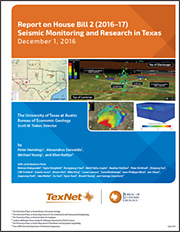Synopsis: Seismicity detection and characterization of the Ft. Worth Basin
Project Status: active
Funding Source: 100% TexNet and other sources
Research Leaders: Heather DeShon, Cliff Frohlich
Project Start: 3Q2015
Project Interface: Project closely interfaces with Texas Seismicity Studies, Faults and Geomodels, Basin-Scale Assessment of Fault Reactivation and Seismicity Potential, Seismic Hazard and Risk Assessment - Shaking Intensity, and Multi-Institutional and Industrial Collaboration for Geomechanical and Seismicity Assessment of the Ft. Worth Basin
Expected research outcomes:
- EQ source spectra
- EQ ground motions, local attenuation
- EQ data for determining shake maps
- EQ data to improve Vs30 maps in north Texas
Seismology research is an important component of TexNet and CISR and it complements and supports the other research elements. Detailed spatial and temporal earthquake observations provide rich datasets to investigate the physics of faulting – essential to all of the other components of the integrated research plan. Seismicity in the Ft. Worth Basin proximal to the population centers of the DFW area constitute a high priority for near-term study.
To understand the nature, causal processes, and associated hazard of recent North Texas earthquake sequences, local observations from temporary seismic networks are essential. Currently SMU operates a 30+ station local network with instrumentation provided by SMU, IRIS and USGS. Data are available in near real-time through the IRIS Data Management Center (DMC). Stations are currently deployed to monitor the 2013-15 Azle swarm, the 2014-2015 Irving/Dallas swarm, and the 2015 M4 Venus sequence. Past deployments include the DFW International Airport and 2009-2010 Cleburne sequences. Under other funding, SMU produces a 1-3 day delayed earthquake catalog to collaborators, including Richter magnitude estimates; fault studies of Azle and Irving sequences using double-difference location and tomographic imaging approaches and focal mechanisms calculations; and analysis of active source data and fault structure in the Fort Worth Basin. Deployment of TexNet permanent and portable seismic stations with replace and/or augment this existing network beginning in mid-2016.
More detailed earthquake source characterization is needed, however, to understand the similarity and differences between recently reactivated intraplate faults in Texas and active seismic zones. These studies, to be conducted by a postdoctoral researcher and a graduate student, aim to systematically document source parameters (seismic moment, stress drop, radiated energy), explore earthquake scaling relationships, and calibrate Fort Worth Basin local magnitudes with moment.
As part of the proposed work, we will produce source spectra, ground motions, and a local attenuation relationship that will aid other TexNet-CISR projects. This project is focused more holistically on Texas. A hypothesis to be directly tested with this work is that induced earthquakes lead to a reduced stress drop when compared to non-induced earthquakes.
Two additional avenues of research derive from the products proposed here or may be pursued through other funding. The first is use of high-resolution differential times produced via waveform correlation to calculated in-situ Vp/Vs. The ratio of compressional to shear velocity is sensitive to the presence of fluids. Anomalous Vp/Vs ratios along active faults in the Fort Worth Basin may provide important information on causal processes. Currently, De Shon (SMU), Walter (UT), and Brudzinski (Miami-Ohio) are conducting waveform correlation and/or template matching studies of North Texas earthquakes that produce high-resolution differential times for this type of study. The second avenue of research is calculation of temporal or spatial b-value variability. Once local magnitudes are properly calibrated, we can conduct high-resolution b-value studies. One hypothesis to be tested is that faulting in the Ellenburger limestone has higher b-values (more smaller earthquakes than expected relative to larger earthquakes) while faulting in the basement follows tectonic b-value scaling (b-value ~1).
